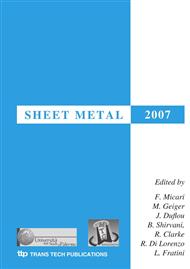p.745
p.751
p.759
p.767
p.777
p.783
p.791
p.799
p.807
Experimental Study on Specimen and Grain Size Effects in Uniaxial Tension Test of Aluminum Foil
Abstract:
With the rapidly growing demand for the micro-thin-wall parts, the development of high accurate forming processes for very thin sheet or foil becomes more and more important. The aim of this study is to explore the effects of specimen width and grain size on tensile strength of aluminum alloy 3003 foil in uniaxial tension test. The problem was approached in two ways: firstly, by reduction of the specimen width, and secondly, by changing the grain size through annealing crystallization. The uniaxial tension tests were performed on an electronic universal material testing machine, in which a linear CCD based visual extensometer was used to measure deformation. The results show that the tensile strength decreases with decreasing specimen width or increasing surface-to-volume ratio. The tensile strength decreases with decreasing grain size for grain sizes larger than the specimen thickness.
Info:
Periodical:
Pages:
777-782
Citation:
Online since:
July 2007
Authors:
Keywords:
Price:
Сopyright:
© 2007 Trans Tech Publications Ltd. All Rights Reserved
Share:
Citation:


